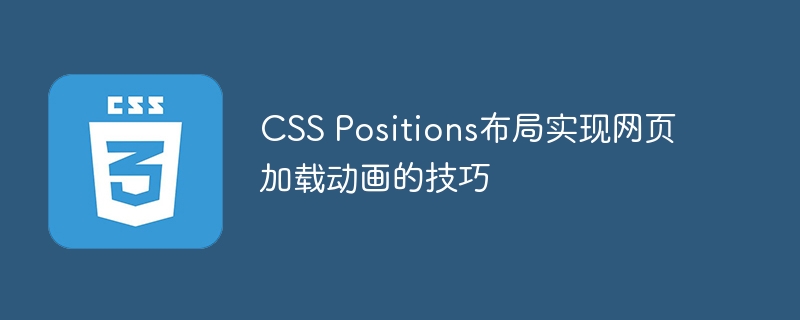

CSS Positions Layout Tips for Implementing Web Page Loading Animation
In today's Internet era, web design pays more and more attention to user experience, among which web page loading animation is to attract the user's attention. one of the important elements. CSS Positions layout is a commonly used web page layout method. By using it appropriately, you can achieve the effect of web page loading animation. This article will introduce how to use CSS Positions layout to implement web page loading animation techniques, and provide some specific code examples.
1. Understand CSS Positions layout
CSS Positions layout refers to controlling the positioning of elements in the web page by setting the position attribute. There are four commonly used position attribute values, namely static, relative, absolute and fixed.
2. Use CSS Positions layout to realize web page loading animation
By using relative positioning attributes and CSS animation Effect, you can achieve some simple web page loading animation effects, such as rotation, scaling and movement, etc.
.loader {
position: relative;
width: 50px;
height: 50px;
border: 5px solid #f3f3f3;
border-top: 5px solid #3498db;
border-radius: 50%;
animation: spin 2s linear infinite;
}
@keyframes spin {
0% { transform: rotate(0deg); }
100% { transform: rotate(360deg); }
}In the above example, we created a div named loader, set its position attribute to relative, and then implemented the rotating loading animation effect through CSS animation technology.
In addition to relative positioning, absolute positioning can also be used to achieve some unique loading animation effects. By setting the position attribute of the element to absolute and using CSS animation features, we can achieve some scaling and fading effects.
.box {
position: absolute;
width: 100px;
height: 100px;
background-color: #3498db;
opacity: 0;
animation: fade 2s linear infinite;
}
@keyframes fade {
0%, 100% { opacity: 0; }
50% { opacity: 1; }
}In the above code, we create a div named box and set its position attribute to absolute. Achieve the fade-in and fade-out effect by setting the opacity attribute, and control the animation duration and cycle through CSS animation technology.
Fixed positioning is suitable for elements that need to maintain their position when the web page is scrolled. It is characterized by positioning relative to the browser window. By setting the position attribute of the element to fixed and combining it with some CSS animation effects, we can create some loading animation effects that are fixed in the corners of the web page.
#loader {
position: fixed;
top: 20px;
right: 20px;
width: 50px;
height: 50px;
border: 5px solid #f3f3f3;
border-top: 5px solid #3498db;
border-radius: 50%;
animation: spin 2s linear infinite;
}
@keyframes spin {
0% { transform: rotate(0deg); }
100% { transform: rotate(360deg); }
}In the above example, we created a div with the ID of loader and set its position attribute to fixed to achieve fixed positioning. Adjust the position of the element on the page by setting the top and right attributes, and use CSS animation technology to achieve a rotating loading animation effect.
Summary:
By rationally using CSS Positions layout and CSS animation features, we can achieve a variety of web page loading animation effects. In the process of writing web pages, we can choose the appropriate positioning method according to the design needs, and combine it with CSS animation technology to create attractive loading animation effects and improve user experience.
The above is an introduction to the techniques of CSS Positions layout to implement web page loading animation, and relevant specific code examples are provided for reference. I hope to be helpful!
The above is the detailed content of CSS Positions layout techniques to implement web page loading animation. For more information, please follow other related articles on the PHP Chinese website!